I've complained before that our railway system has developed the habit of withdrawing services to allow engineering works to take place at what long-suffering passengers consider to be inappropriate times. The weekend we travelled, early in the New Year, less than half the usual trains were running between London and Brighton and these were terminating at Three Bridges with the journey being completed by Rail Replacement Buses. In the spirit of adventure, we endured these arrangements and enjoyed our time in Brighton.
We arrived at East Croydon station with only a short wait before the service as far as Three Bridges. The station was busy and there seemed to be a fair amount of confusion amongst passengers regarding the temporary arrangements which harrassed staff were attempting to address, not helped by a lack of signage or co-ordinated visual and audible announcements on the various 'Passenger Information Systems'. The train was well-loaded but proceeded reasonably enough to Three Bridges, with a stop at Gatwick Airport.
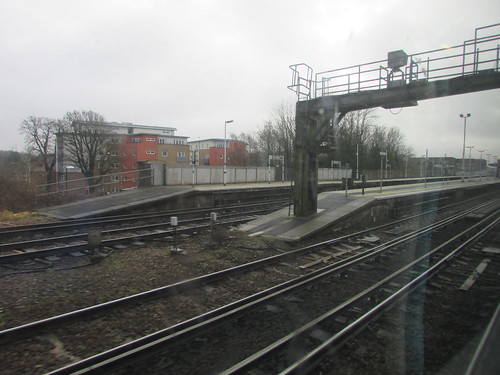
Arriving at Three Bridges.
A busy 12-coach train discharging all its passengers at Three Bridges rather challenged the station facilities. I saw little in the way of signage and station announcements were inaudible but we had little alternative to being swept along in the crowd, down the long subway ramp and out through a side entrance on the Up side, where I saw one small printed sign with an arrow saying 'Buses'. We had to climb steps, cross a busy car park access road and enter a large, featureless car park. I saw a few people in high visibility jackets, who appeared to be hired-in security. They were studiously avoiding the crowd surging past in favour of the attractions of the screens of their various mobile phones. We followed the crowd towards the back of the car park where coaches and buses from a number of firms were parked, with a variety of stickers in the front windows, just a number, 'Rail Replacement' or the slightly more helpful 'Brighton'. I'd managed to work out that there were two types of bus to Brighton, direct and calling at all intermediate stations but none of the signs gave that information. I asked a young marshal which was the 'Direct Brighton' coach and he was very definite in identifying the correct coach. So my friend and I clambered up the steps to the high-level floor of the long-distance coach and found seats. After a short wait, another marshal appeared and announced that we were, in fact, on the 'All Stations' coach and directed us to another coach some distance away, apologising briefly for his colleague's error. With a groan, about a dozen misdirected travellers got off and we all made our way to the other bus, with a similar set of steps to be negotiated.
Finally, the coach set off but took around 45 minutes to complete the journey to Brighton, taking some time to thread its way through the heavy traffic past Preston Park and into the centre of Brighton, where narrow streets led us to the station's pick-up and drop-off area, some distance from the front entrance of the station. Relieved at actually being in Brighton, we set off on the walk towards the station buildings, on which I was happy to distract myself studying the Train Shed, a magnificent Victorian structure with two main arches and a smaller one on the Down side which we passed under to reach the concourse. There was a limited service of trains being run on the other lines radiating from Brighton, but the majority of travellers seemed to be trooping to and from the temporary bus terminal we'd just arrived at.
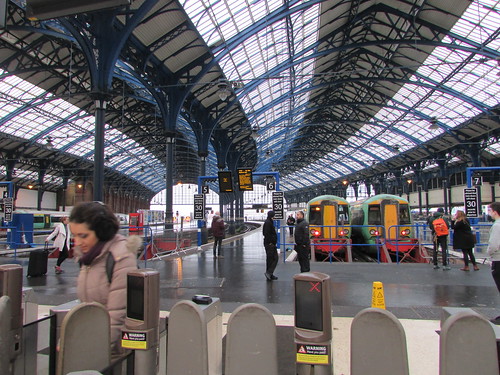
Brighton station, viewed from the Gate Line.
In the civilised way that used to be commonplace at major railway stations, having passed through the entrance of the main station building we came to a covered taxi rank with a number of waiting vehicles and were soon on our way to the Grand Hotel through a Brighton crowded with Saturday shoppers. The hotel currently rather lacks its external grandeur having started, in October 2016, a major project to restore the facade but the top-hatted doorman was welcoming enough. The reception area was exceptionally busy, dealing with enrolment for the BRIGHTON AREA INTERGROUP – 14TH AA WEEKEND CONVENTION. As a result, both the dining room and the terrace overlooking the sea were unavailable. We did take a simple lunch in the bar/coffee shop area of the ground floor but there were signs of the pressure the staff were under.

Brighton: Grand Hotel, looking towards entrance.
Having obtained a street map, we decided to walk to an area of the old town called 'The Lanes' - a network of narrow passages and small shops that, when I was younger, were the haunt of a myriad antique shops. But, to my disappointment, the area appears to have been largely modernised and is mainly multiple eating opportunities and clothing stores, lacking the character I remember but still very successful in attracting visitors.
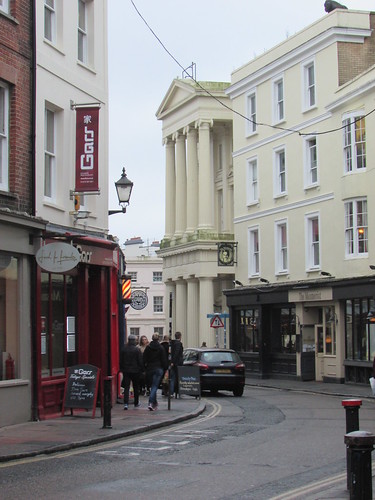
Brighton: Town Hall.
After some time exploring the interesting alleyways, we walked along North Street and admired the Chapel Royal. This dates from 1793 when the foundation stone was laid by the Prince Regent. The present rather odd architectural style with brick, flint and terracotta results from repairs and alterations by Arthur Blomfield towards the end of the 19th century when the clock tower was added. There's a Wikipedia article here.
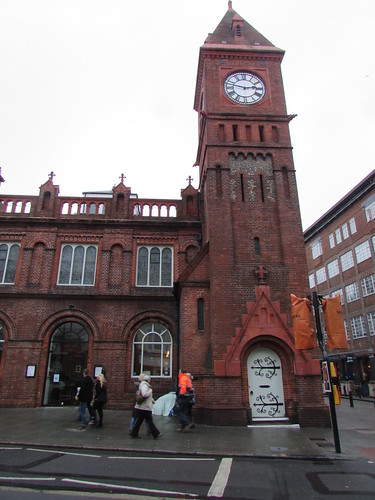
Brighton: Chapel Royal.
Next, we studied the outside of the Royal Pavilion, an exotic pleasure palace developed for the future King George IV from a more modest building by John Nash, starting in 1815. In 1851, the Royal Pavilion was opened as a public attraction, having been purchased by Brighton from Queen Victoria the previous year. There's more about the Royal Pavilion on Wikipedia here and an excellent full-colour Souvenir Guide & Catalogue (see 'Related books' below).
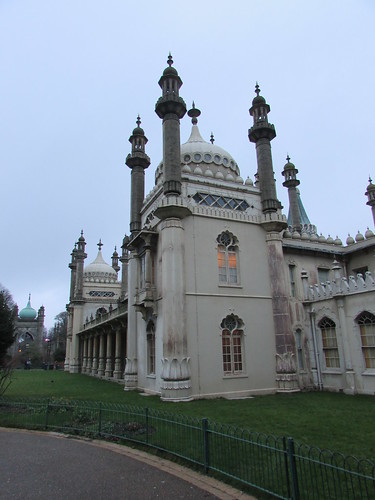
Brighton: Royal Pavilion.
Just outside the Royal Pavilion is the India Gate, whose interesting history I'd forgotten. The Indian Memorial Gate was a gift from India following World War I, given in thanks for the the care given to around 12,000 wounded Indian soldiers in Brighton at hospitals set up in the Royal Pavilion and other locations. There's a detailed report on the opening ceremony in 1921 here and an interesting article on the 'Sikh Museum' site here.
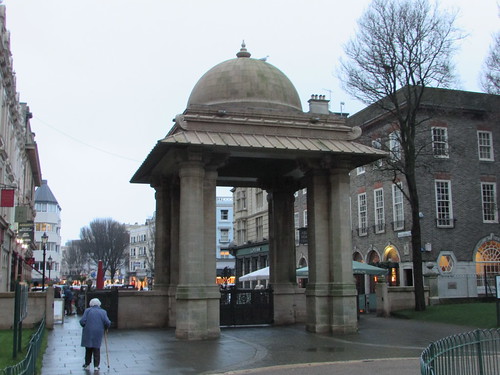
The Indian Memorial Gate, outside the Royal Pavilion.
In 1841, a railway had been opened from London to Brighton by the London and Brighton Railway but earnings were initially disappointing. In 1846, disgruntled shareholders forced amalgamations to form the London, Brighton and South Coast Railway (LBSCR) and the railway made serious attempts to encourage 'trippers'. With attractions like the Royal Pavilion, the rail traffic grew. You can read more about the origins of the railway in the post Origins of the Southern Railway: Part 2: L.B.S.C.R..
We made our way to the promenade just by the concrete and stone groyne bearing the public artwork Afloat. This represents our planet transformed into a 'Donut' (technically, a torus). An interesting idea, but not for me, I'm afraid. To the east, lights were appearing along the length of the Palace Pier.
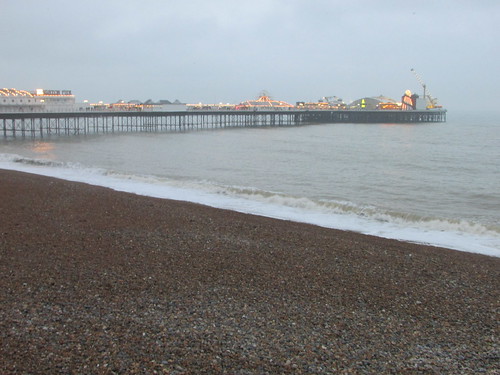
Brighton: The Palace Pier.
To the west stood the dark, sad skeleton of the West Pier, opened in 1866, closed in 1975 and seriously damaged by collapse and fire since 2002. The pier structure still stands (in rebuke?) near the not-universally-welcomed 'i360', sorry, the British Airways i360, opened in 2016. This is "the world's slenderest tall tower", 531 feet tall and lifting up to 200 people at a time to a height of 435 feet. There's a Wikipedia article here. I'll reserve judgment until I've tried it.
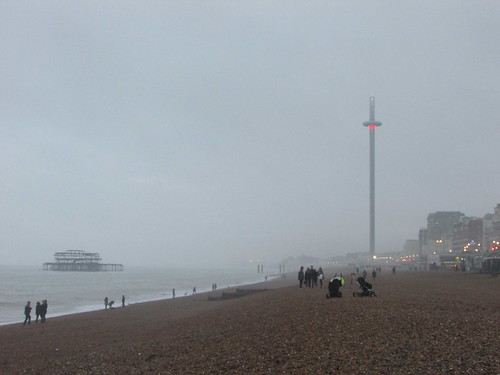
Brighton: The remains of the West pier and the i360 observation tower.
We'd had a recommendation to try the Mock Turtle Tea Room - a traditional tea shop hidden in a side street near East Street which revived us with tea and teacakes. The 'Mock Turtle' is, of course, a fictional character in Lewis Carroll's book 'Alice's Adventures in Wonderland' but I didn't realise, until I consulted the Wikipedia article here, that Mock Turtle Soup was a popular dish in Victorian times providing a cheap substitute for Green Turtle Soup. We walked to the nearest taxi rank and took a taxi back to the front of Brighton Station.
There were plenty of passengers about, but staff seemed to be confined to security staff mournfully watching the passing crowds. The normal electronic Passenger Information Displays situated near the ticket barriers on the concourse had been updated to give a slight hint as to the use of buses, showing buses as if they were trains, without a platform number but with a scrolling note at the bottom of the screen reading 'Bus leaves from car park ...' but with no guidance I could spot as to how you reached the car park. Of course, we knew the rather improbable pedestrian route we had to take from our arrival earlier in the day but I sympathised with the uncertainty some travellers displayed. Once we emerged from the train shed into the darkened bus pick-up area, we could see large crowds and some buses. I asked an apparent member of staff where the direct Three Bridges bus loaded. She expertly duped me by pointing to the swirling crowd and claiming "the man with a clipboard over there has details of the buses". Of course, there was no 'man with a clipboard' just rather gladiatorial jousting as people clambered on buses. We abandoned the nearest bus as both not indicating its route and also being unlikely to have free seats by the time we succeeded in boarding. At a somewhat calmer area around a similarly anonymous bus, the driver was getting off and confirmed he was going to Three Bridges without intermediate stops so we gratefully boarded. I was quite surprised when we moved off promptly and made fairly good time to Three Bridges.
To my relief, on arrival at the station, the bus stopped at the ramped entrance to the main station building, so we had only a short walk to the ticket barriers, which we bypassed because a wide access gate had been opened. I spotted an employee in the darkness by the Gate Line Control panel. He seemed quite startled when asked what platform we would require but his answer proved correct. We went up the long ramp to the platform he'd suggested and, within a few minutes, a train arrived which conveyed us back to East Croydon without further excitement. We had a good day but very little credit goes to the Government, the Infrastructure Operator (the dreadful Network Rail) and the Train Operating Company (the reviled Southern) for allowing our national railway system to descend to such a poor level of service. The Southern franchise has been in dispute with its staff for over nine months over the extension of Driver Only Operation (DOO) and two days later, Southern drivers started a further series of strikes which paralysed the system. Separate strikes by London Underground staff heightened the misery for commuters.
Related books
[1] ‘The Royal Pavilion Brighton:Souvenir Guide & Catalogue’ edited by David Beevers (Brighton & Hove City Council) ISBN 0-948-72321-1.
My Pictures
Where necessary, clicking on an image above will display an 'uncropped' view or, alternately, my pictures from this (and earlier) trips may be selected, viewed or downloaded, in various sizes, from the albums listed:-
East Croydon Area Rail.
Brighton area rail.
Brighton.
['Souvenier Guide' reference added: 23-Jan-2017]
